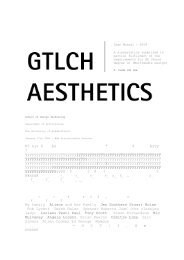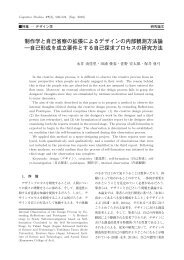Williamson
Williamson
Williamson
You also want an ePaper? Increase the reach of your titles
YUMPU automatically turns print PDFs into web optimized ePapers that Google loves.
© Beth <strong>Williamson</strong> 2008<br />
Fig. 3: Example of student's work from Tease and Worry book, Goldsmith's<br />
College 1965/6. Courtesy of the artist John Steers.<br />
Ehrenzweig replaced Basic Design sketch books with ‘Tease and Worry’ books<br />
where students were expected to write notes, draw, paint, or work in any way<br />
they felt appropriate (fig. 3). The purpose was to track down images, in the<br />
manner of free association, for which the only criterion was that they were felt<br />
right or rang true. 46 Classes changed and mutated in real time, taking account<br />
of the needs of individual students and events as they arose. This responsive<br />
way of working encouraged students to follow through ideas as they happened.<br />
In an environment where spontaneity was privileged and established<br />
convention spurned, planned exercises and learning became unnecessary. The<br />
ATC course was, by Ehrenzweig’s own admission, ‘an experimental course for<br />
art teachers’ and so required him to reflect on its efficacy. In a 1965 paper,<br />
Towards a Theory of Art Education, Ehrenzweig writes about the need to make<br />
students aware of the sorts of things that might block or release their own<br />
re·bus Issue 2 Autumn 2008 18





